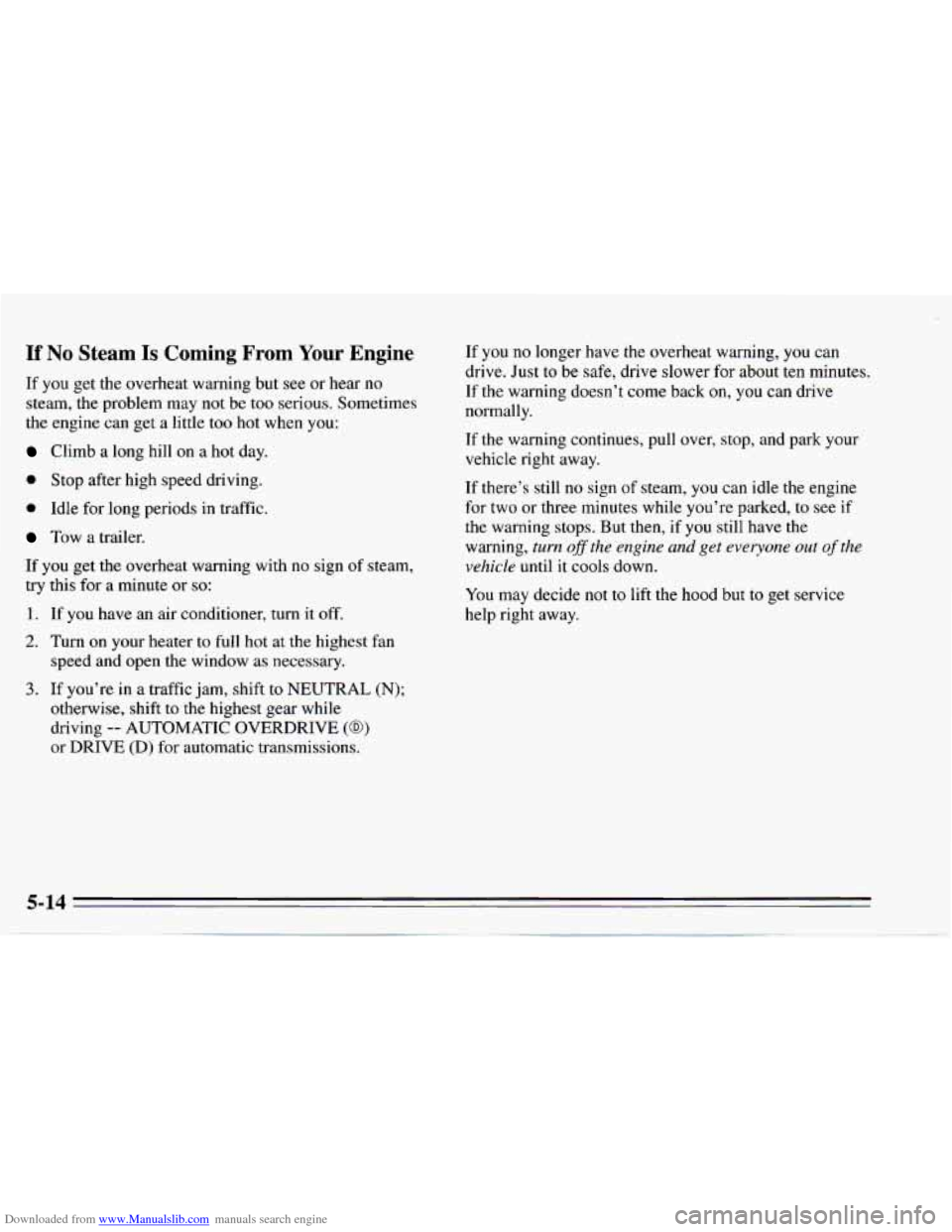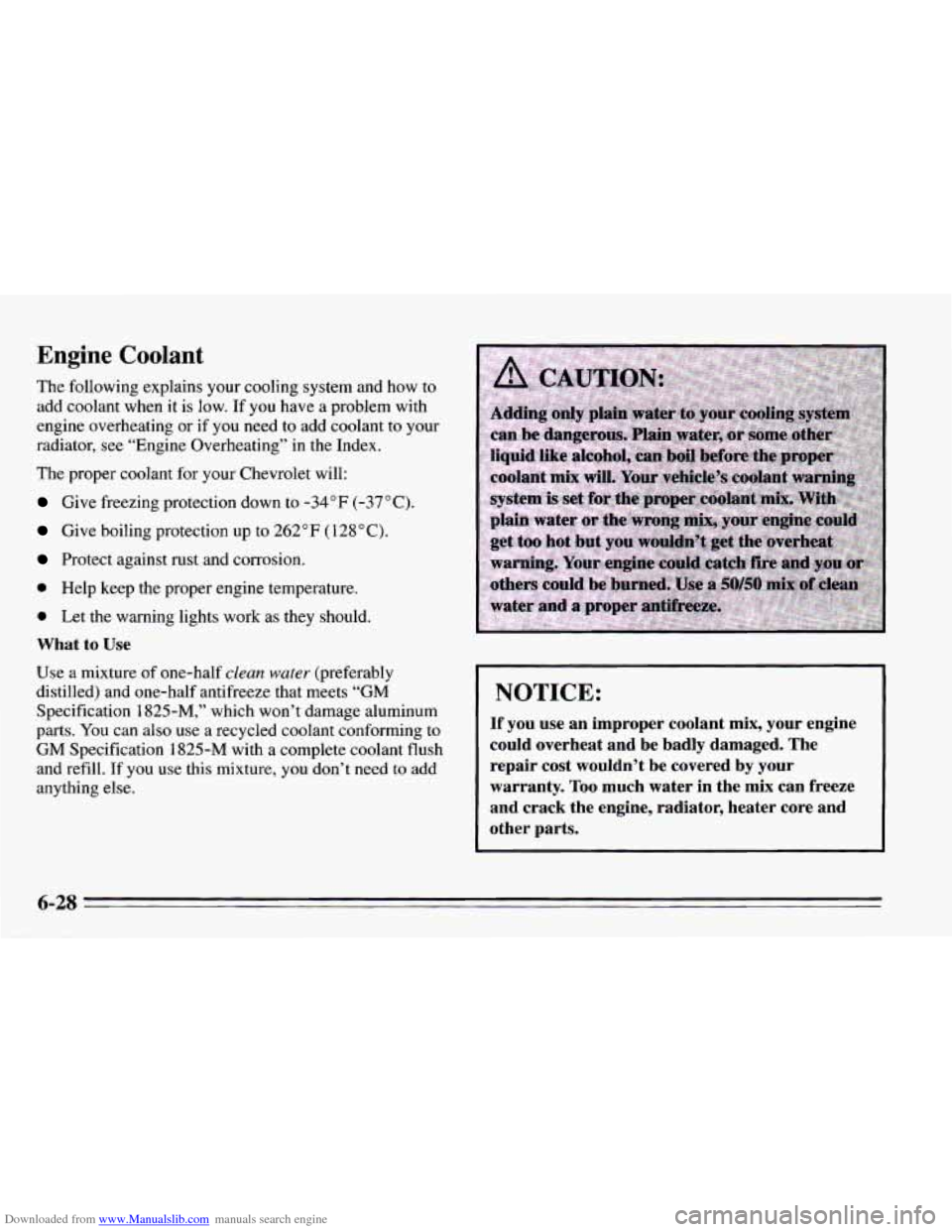Page 207 of 388
Downloaded from www.Manualslib.com manuals search engine Engine Overheating
You will find a coolant temperature gage on your
Chevrolet’s instrument panel.
You may also find a low
coolant warning light on your Chevrolet’s instrument
panel.
If Steam Is Coming From Your Engine
NOTICE:
If your engine catches fire because you keep
driving with
no coolant, your vehicle can be .
badly damaged. The costly repairs would not be
covered by your warranty.
Page 208 of 388

Downloaded from www.Manualslib.com manuals search engine If No Steam Is Coming From Your Engine
If you get the overheat warning but see or hear no
steam, the problem may not be
too serious. Sometimes
the engine can get a little too hot when you:
Climb a long hill on a hot day.
0 Stop after high speed driving.
0 Idle for long periods in traffic.
Tow a trailer.
If you get the overheat warning with no sign
of steam,
try this for a minute or
so:
1. If you have an air conditioner, turn it off.
2. Turn on your heater to full hot at the highest fan
speed and open the window as necessary.
3. If you’re in a traffic jam, shift to NEUTRAL (N);
otherwise, shift to the highest gear while
driving
-- AUTOMATIC OVERDRIVE (a)
or DRIVE (D) for automatic transmissions. If you
no longer
have the overheat warning, you can
drive. Just
to be safe, drive slower for about ten minutes.
If the warning doesn’t come back
on, you can drive
normally.
If the warning continues, pull over, stop, and park your
vehicle right away.
If there’s still no sign
of steam, you can idle the engine
for two or three minutes while you’re parked,
to see if
the warning stops. But then, if you still have the
warning,
turn ofSthe engine and get everyone out of the
vehicle
until it cools down.
You may decide not to lift the hood but to get service
help right away.
Page 210 of 388
Downloaded from www.Manualslib.com manuals search engine If the coolant inside the coolant recovery tank is boiling,
don’t
do anything else until it cools down.
When
it is cool, remove the coolant recovery tank cap
and look at the dipstick. The coolant
level should be
FULL COLD. If it isn’t, you
may have
a leak in the radiator hoses, heater hoses,
radiator, water pump
or somewhere else in the cooling
system.
I NOTICE:
Engine damage from running your engine
without coolant
isn’t covered by your warranty.
If there seems to be no leak, with the engine on check to
see if the electric engine fan is running. If the engine is
overheating, the fan should be running. If it isn’t, your
vehicle needs service.
Page 212 of 388
Downloaded from www.Manualslib.com manuals search engine When the coolant in the coolant recovery tank is at
FULL COLD, start your vehicle.
If the overheat warning continues, there’s one more
thing you can try. You can add the proper coolant mix
directly
to the radiator, but be sure the cooling system is
cool before you do it.
5-18
Page 216 of 388
Downloaded from www.Manualslib.com manuals search engine 8. Then replace the pressure cap. At any time during
this procedure if coolant begins to flow out
of the
filler neck, reinstall the pressure cap. Be sure the
arrows
on the pressure cap line up like this.
How to Add Coolant to the Radiator - LT1
(Code P) Engine Only
NOTICE:
The LT1 Engine (Code P) has a specific radiator
fill procedure. Failure
to follow this procedure
could cause your engine to overheat
and be
severely damaged.
5-22
Page 260 of 388

Downloaded from www.Manualslib.com manuals search engine Engine Coolant
The following explains your cooling system and how to
add coolant when it
is low. If you have a problem with
engine overheating or if you need to add coolant to your
radiator, see “Engine Overheating”
in the Index.
The proper coolant for your Chevrolet will:
Give freezing protection down to -34°F (-37°C).
Give boiling protection up to 262” F ( 128 * C).
Protect against rust and corrosion.
0 Help keep the proper engine temperature.
0 Let the warning lights work as they should.
What to Use
Use a mixture of one-half clean water (preferably
distilled) and one-half antifreeze that meets
“GM
Specification 1825-M,” which won’t damage aluminum
parts.
You can also use a recycled coolant conforming to
GM Specification 1825-M with a complete coolant flush
and refill. If you use this mixture, you don’t need to add
anything else.
I NOTICE:
If you use an improper coolant mix, your engine
could overheat and
be badly damaged. The
repair
cost wouldn’t be covered by your
warranty.
Too much water in the mix can freeze
and crack the engine, radiator, heater core and
other parts.
6-28
Page 261 of 388
Downloaded from www.Manualslib.com manuals search engine Adding Coolant
To Check Coolant
When your engine is cold, check the dipstick on the cap
of the coolant recovery tank. The coolant level should
be at
COLD, or a little higher. When your engine is
warm, the level on the dipstick should be up to the HOT,
or a little higher.
5.7L LT1 Engine Only
If this light comes on, it means you’re low on engine
coolant.
To Add Coolant to the Recovery Tank
If you need more coolant, add the proper mix ut the
coolant
recovery tank, but only when your engine is
cool. If the tank is very low or empty, also add coolant
to the radiator, see “Engine Overheating” in the Index
for information.
6-29
Page 262 of 388
Downloaded from www.Manualslib.com manuals search engine I
I
1 Add coolant mix at the recovery tank, but be careful not
, to spill it.
Radiator Pressure Cap (All Engines)
NOTICE:
Your radiator cap is a 18 psi (124 kPa)
pressure-type cap and must be tightly installed to
prevent coolant loss and possible engine damage from overheating. Be sure the arrows on the cap
line
up with the overflow tube on the radiator
filler neck.
When you replace your radiator pressure cap, an AC@
cap is recommended.
Thermostat
Engine coolant temperature is controlled by a thermostat
in the engine coolant system. The thermostat stops the
flow of coolant through the radiator until the coolant
reaches
a preset temperature.
When you replace your thermostat, an
AC@ thermostat
is recommended.
6-30